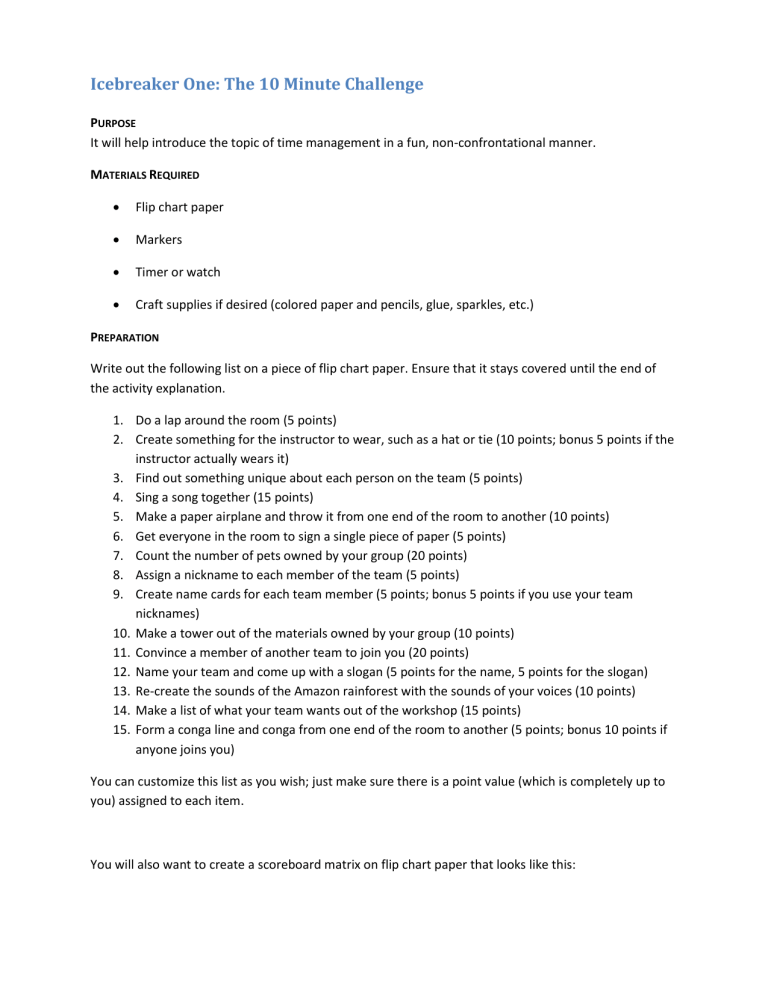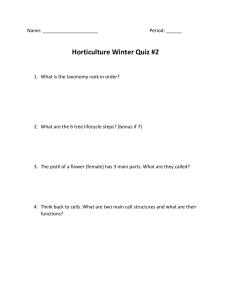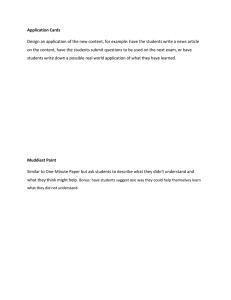
Icebreaker One: The 10 Minute Challenge PURPOSE It will help introduce the topic of time management in a fun, non-confrontational manner. MATERIALS REQUIRED Flip chart paper Markers Timer or watch Craft supplies if desired (colored paper and pencils, glue, sparkles, etc.) PREPARATION Write out the following list on a piece of flip chart paper. Ensure that it stays covered until the end of the activity explanation. 1. Do a lap around the room (5 points) 2. Create something for the instructor to wear, such as a hat or tie (10 points; bonus 5 points if the instructor actually wears it) 3. Find out something unique about each person on the team (5 points) 4. Sing a song together (15 points) 5. Make a paper airplane and throw it from one end of the room to another (10 points) 6. Get everyone in the room to sign a single piece of paper (5 points) 7. Count the number of pets owned by your group (20 points) 8. Assign a nickname to each member of the team (5 points) 9. Create name cards for each team member (5 points; bonus 5 points if you use your team nicknames) 10. Make a tower out of the materials owned by your group (10 points) 11. Convince a member of another team to join you (20 points) 12. Name your team and come up with a slogan (5 points for the name, 5 points for the slogan) 13. Re-create the sounds of the Amazon rainforest with the sounds of your voices (10 points) 14. Make a list of what your team wants out of the workshop (15 points) 15. Form a conga line and conga from one end of the room to another (5 points; bonus 10 points if anyone joins you) You can customize this list as you wish; just make sure there is a point value (which is completely up to you) assigned to each item. You will also want to create a scoreboard matrix on flip chart paper that looks like this: TEAM 1 TEAM 2 TEAM 3 TASK 1 TASK 2 TASK 3 TASK 4 (AND ON…) TOTAL This should stay hidden until the end of the activity. EXPLANATION Divide participants into teams of five to eight. Unveil the numbered list of tasks. Explain that they have ten minutes to collect as many points as possible. They must be safe and they only have ten minutes! ACTIVITY Give participants ten minutes to perform their tasks, and enjoy the show! After ten minutes, add up their points using your pre-designed matrix and announce the winner. Keep the list of tasks; you may want to tape it to the wall. DEBRIEF After the activity, discuss learning points. Possible discussion topics include: How did teams decide what tasks they wanted to do? Most groups will analyze the time the task will take and/or the difficulty level, compare it with the value (possible number of points), and prioritize as a result. We do this when managing our time, too: we often choose the high-yield, low-effort tasks over the low-yield, high-effort tasks (and rightly so!). Were any decisions based on task dependencies? For the name card task, for example, teams received bonus points if they used team nicknames. Performing these two tasks together would triple the points received. This often happens in life, too – batching tasks increases your results exponentially. What group dynamics came into play? If participants knew each other before, they may feel more comfortable performing a personally risky activity, like singing a song. This comes into play when prioritizing tasks, too; we’re more likely to stay within our comfort zone, especially if we’re working in a team. What skills came into play? For example, several tasks involved creativity and artistic skills. Did teams find out whether any members had artistic talent before deciding to do the task? What additional information did you ask for? How did that affect your approach? Some groups will catch on to the fact that there is no rule that the whole group must perform every task, and will divide their resources and achieve more points as a result. The lesson to learn here is that you need all the information you can get before prioritizing tasks and making a plan. Some teams may have even realized this partway through the activity and adjusted their approach as a result. Kudos to them! Did ethics come into play? Although “stealing” another team member was worth a lot of points, some teams are uncomfortable with the idea and avoid this task.

